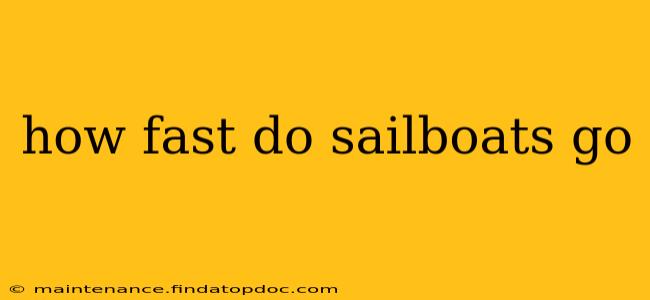The speed of a sailboat isn't a simple answer; it's a complex interplay of several factors. Unlike motorboats with a fixed maximum speed, a sailboat's velocity is highly variable, depending on the boat's design, the conditions of the wind and sea, and the skill of the sailor. Let's explore the key elements affecting sailboat speed.
What Determines a Sailboat's Speed?
Several crucial factors influence how fast a sailboat can travel:
-
Boat Design: The hull shape, sail plan (size and type of sails), and keel design significantly impact performance. A long, narrow hull with a deep keel and a large sail area will generally be faster than a shorter, wider boat with a smaller sail area. Modern racing yachts are optimized for speed, while cruising boats prioritize comfort and stability.
-
Wind Speed and Angle: The speed and direction of the wind are paramount. Sailboats are most efficient when sailing at an angle to the wind (close-hauled), but can still make progress sailing almost directly downwind (running). Stronger winds generally translate to faster speeds, up to a point where the boat becomes overpowered and less efficient.
-
Sea Conditions: Waves and currents can drastically affect speed. Following waves can increase speed, while head-on waves create significant drag, slowing the boat down. Strong currents can either assist or hinder progress, depending on their direction.
-
Sail Trim and Handling: The skill of the sailor in adjusting the sails (trim) to optimize their shape and angle to the wind is critical for maximizing speed. Proper boat handling, anticipating wind shifts and wave patterns, further enhances performance.
How Fast Can Different Types of Sailboats Go?
Sailboat speeds vary widely depending on their type and the conditions. Here's a general overview:
-
Racing Sailboats: These highly optimized boats can reach speeds exceeding 30 knots (approximately 35 mph) in ideal conditions (strong winds and favorable waves). They are designed for speed above all else.
-
Cruising Sailboats: These boats prioritize comfort and liveability over pure speed. Their typical speeds range from 5 to 8 knots (6-9 mph) in moderate winds. They might reach speeds up to 10 knots (11.5 mph) in strong winds.
-
Small Sailboats (Dinghies & Daysailers): These smaller boats are generally slower, typically achieving speeds of 4-6 knots (4.5-7 mph) in moderate winds.
What is the Fastest Sailboat Ever?
Determining the absolute fastest sailboat ever is tricky, as different races and conditions make direct comparisons challenging. However, some cutting-edge hydrofoiling boats have achieved speeds exceeding 50 knots (57 mph) in bursts, pushing the boundaries of sailing technology.
How Fast Can a Sailboat Go Downwind?
Sailing downwind (running) allows for higher speeds compared to sailing close-hauled. The boat's ability to harness the wind's power and minimize drag influences its speed. Many sailboats can achieve speeds twice their hull speed (a rough calculation based on hull length) in ideal downwind conditions.
How Fast Can a Sailboat Go Upwind?
Sailing upwind (close-hauled) is less efficient than downwind sailing. The angle to the wind requires more tactical sailing, and progress is slower. Speeds upwind are usually lower than downwind speeds, depending on wind conditions and boat design.
What is the Average Speed of a Sailboat?
The average speed of a sailboat is difficult to pinpoint due to the considerable variables involved. A reasonable estimate for cruising sailboats in moderate conditions might be around 6 knots (7 mph). However, this is merely an approximation, and actual speeds will vary greatly.
This comprehensive overview provides a clearer picture of the factors affecting sailboat speed. Remember, the experience is as important as the speed; enjoying the journey is just as crucial as reaching the destination.
